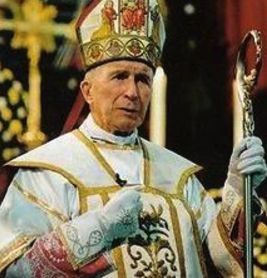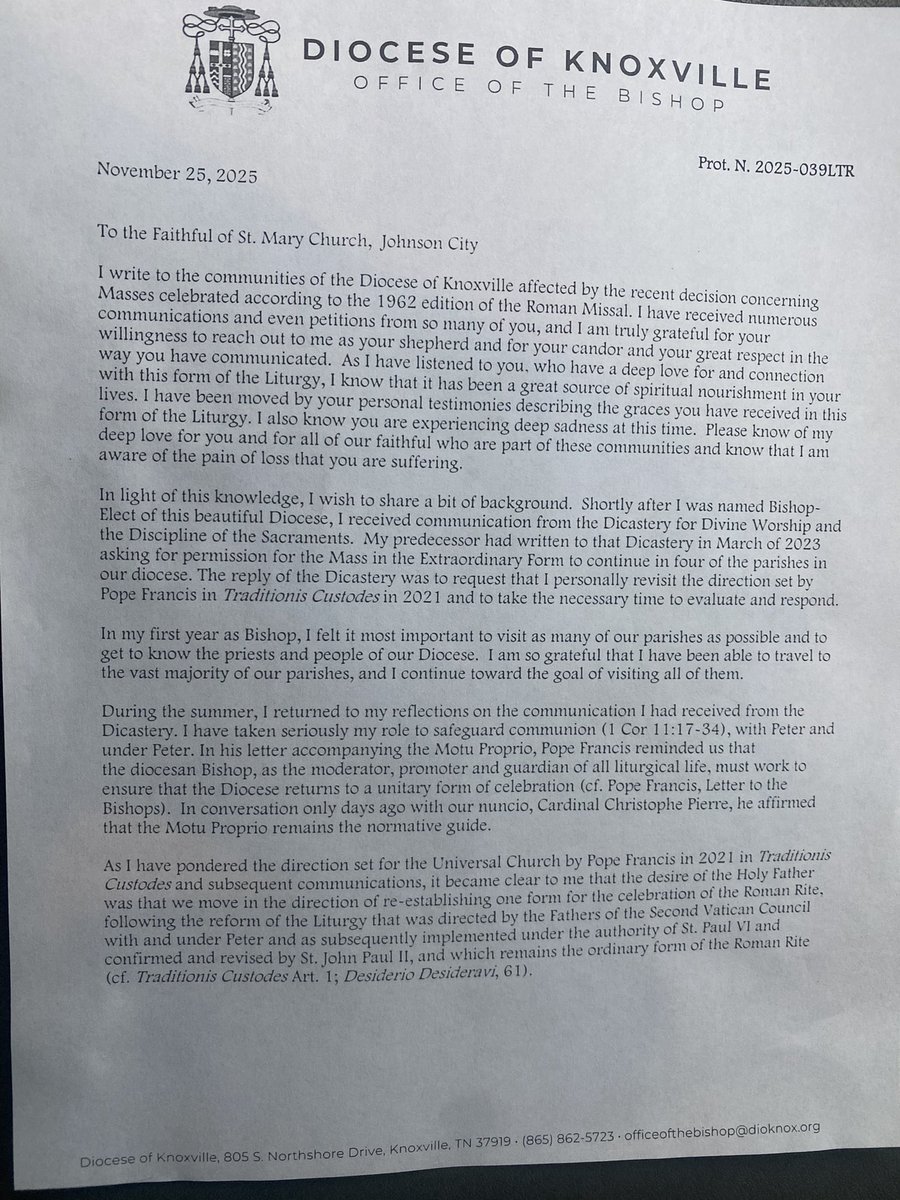Neal Webster botches episcopal consecration
No Bishop Pfeiffer: Feeneyite Fails at Attempt to Consecrate Bishop for SSPX-Resistance

Bp. Neal Webster mangles the essential words necessary for validity
Big news out of Boston, Kentucky: This past Wednesday, July 29, 2020, Bp. Neal Webster consecrated Fr. Joseph Pfeiffer a bishop for the SSPX-resistance. That, at least, is the official story. The truth is a bit more complicated.
But first, a little bit of context.
The Society of St. Pius X is a priestly society founded by Abp. Marcel Lefebvre (1905-1991) with the approval of the local Novus Ordo bishop in Fribourg, Switzerland, in 1970. When on June 30, 1988, Abp. Lefebvre, joined by Brazilian Bp. Antonio de Castro Mayer (1904-1991), consecrated four bishops in defiance of “Pope” John Paul II’s explicit prohibition, the Vatican declared that all six bishops had incurred automatic excommunication for this “schismatic act”, and John Paul II subsequently warned all about “formal adherence to the schism”. After many years of an ecclesiastical “cold war”, eventually the Lefebvrists and the Vatican began talking again, and in 2009 “Pope” Benedict XVI lifted the excommunications against the four surviving bishops, with “full communion” still far off, however.
In 2012, as a reconciliation between the SSPX and the Modernist Vatican became a realistic possibility, some Lefebvrist clergy began to dissent and resist openly, the most prominent of them being Bp. Richard Williamson, one of the four consecrated by Lefebvre and de Castro Mayer in 1988. Some clergy began to leave the Society of their own volition, whereas others were expelled. On Oct. 24, 2012, the SSPX leadership under Bp. Bernard Fellay expelled Bp. Williamson, ironically, for failure “to show due respect and obedience to his lawful superiors” — as though any lawful authority (in the canonical sense) had ever appointed Fellay over Williamson. Thus, while Fellay could disobey his own superior (the “Pope”) all day long, Williamson was not permitted to disobey Fellay — but that’s not our topic now.
Before long, these former SSPX clerics began to form in a loose association called by various names, such as “SSPX of the Strict Observance” (SSPX-SO), “SSPX Marian Corps” (SSPX-MC), or simply “SSPX-Resistance.” Their idea is to be as hardline as the SSPX had been before the rapprochement with Rome began, and to oppose any “premature compromise” (source). They see themselves as the “real” SSPX and the true spiritual heirs of Abp. Lefebvre. Some of them gathered around Bp. Williamson, whereas others went their own way. This is where Fr. Joseph Pfeiffer comes in.
Fr. Pfeiffer had been expelled from the SSPX together with Fr. François Chazal in September of 2012. Whereas Fr. Chazal went to Asia, Fr. Pfeiffer ended up establishing his own “church, seminary, and convent”, dedicated to Our Lady of Mount Carmel, in Boston, Kentucky (aka “Pfeifferville”).
Fast-forward to July 29, 2020. Apparently with no prior public announcement, the Feeneyite Bishop (or “Bishop”) Neal Webster consecrated Fr. Pfeiffer a bishop in the Boston chapel (see full video here). It is not clear (to us, at least) whether Webster is a valid bishop because it is not clear whether he is a valid priest, and the validity of an episcopal consecration bestowed upon a man who is not a valid priest is doubtful. It is unnecessary to go into detail here, because the focus of this blog post is another: Even if Webster is a valid bishop, Fr. Pfeiffer’s episcopal consecration this past Wednesday was invalid. In other words, Pfeiffer is not actually a bishop.
The reason for the invalidity lies in the fact that Bp. Webster mangled the sixteen essential words that are absolutely necessary for the episcopacy to be conferred on a priest.
Before we look at the evidence for that, let us first review the applicable principles of Catholic sacramental theology:
15. — 1. – In the administration of the sacraments by fallible ministers it sometimes occurs that the matter and form are not rightly applied, due to inadvertence, negligence, error or deliberate will. In any case the objective change that results will be either substantial or accidental. Judgment of the quality of the change effected will be made not by the criteria of the physical sciences but in accordance with the common usage and estimation of prudent men.
2. – A substantial change takes place when in ordinary usage and prudent estimation the matter no longer remains of the same species and name as that determined in the sacrament (e.g., to use milk in baptizing), or when the words used in the form no longer retain the same sense (e.g., to say “ego to baptizo in nomine matris…”). A change is accidental when the matter remains the same in usage and name but altered in some accidental quality (e.g., to use leavened bread or a square host), or when the words of the form are different but retain the same sense (e.g., to say “ego te abluo…”).
16. — 3. – Regarding corruption or change in the sacramental form St. Thomas notes that, if the change in the words is at the beginning of the words, the sense is generally altered essentially or substantially, but not usually if the change takes place at the end of the words. If the corrupt forms cannot have other than a sacramental sense, they generally remain valid forms. Thus the separation of individual words or of syllables does not constitute a substantial alteration, unless the interval is long enough to alter the meaning of the sentence (more easily admissible when syllables are separated). In such a case the moral unity of the form as one complete prayer is destroyed by the interruption and also by such grammatical changes or mistakes as could actually change the meaning of the form. Substantial alteration may also be risked by faulty articulation or by clipping words through haste. In practice, where a complete word is de facto interrupted through a pause between syllables, it is advisable to repeat the word, unless the interruption is extremely slight.
17. — 4. A substantial change in matter and in form always invalidates a sacrament, whereas a purely accidental change does not have this effect. …
(Rev. Nicholas Halligan, The Administration of the Sacraments [Cork: The Mercier Press, 1963], nn. 15-17, pp. 8-9; italics given; underlining added.)
With this in mind, we can now consider the evidence of how Webster botched the Pfeiffer consecration.
In 1947, Pope Pius XII decreed:
…[I]n the Episcopal Ordination or Consecration, the matter is the imposition of hands which is done by the Bishop consecrator. The form consists of the words of the “Preface,” of which the following are essential and therefore required for validity:
“Comple in Sacerdote tuo ministerii tui summam, et ornamentis totius glorificationis instructum coelestis unguenti rore sanctifica.”
[“Perfect in Thy priest the fullness of thy ministry and, clothing him in all the ornaments of spiritual glorification, sanctify him with the Heavenly anointing.”]
(Pope Pius XII, Apostolic Constitution Sacramentum Ordinis, n. 5; bold print added.)
As can be seen beginning at 59:10 in the video, Webster does not pronounce this sacramental formula correctly. What he actually says is very difficult to transcribe, so we won’t even try. Instead, everyone can listen to it for himself.
The following brief video clip shows how Webster mispronounces the essential words by comparing them to what he should have said:
Thus Webster has rendered the consecration of Fr. Pfeiffer invalid. That is also the judgment of sedevacantists Bp. Donald Sanborn and Fr. Nicolas Desposito, by the way, among others.
Still, not everyone will be totally convinced that Webster’s botching of the essential words rendered the sacrament invalid. Nevertheless, it is beyond any dispute that the mangled words have rendered the validity doubtful. In other words, we cannot know whether the sacrament was conferred or not.
However, in practice Catholic theology requires us to treat a doubtful sacrament as invalid, precisely because we have no certainty that it was in fact conferred validly:
In a doubt of the validity of a sacramental conferral, every sacrament may be repeated conditionally, and certain ones must be repeated. However, the doubt must be prudent and reasonable, since an imprudent and rash doubt causes an irreverence to the sacrament…. Certain necessary sacraments must be repeated lest grave damage to religion or neighbor result: Baptism, absolution of those dying in mortal sin, Extreme Unction for the unconscious moribound, Holy Orders, the consecration of doubtfully consecrated hosts.
(Halligan, The Administration of the Sacraments, n. 48, pp. 20-21; italics given; underlining added.)
It is obvious that there exists at least a doubt that is both prudent and reasonable with regard to how Webster pronounced the essential form, given the evidence provided above.
As someone who has rightly railed against the doubtful/invalid sacraments of the Novus Ordo Church, Fr. Pfeiffer should be most concerned about the status of his own validity as a “bishop.” In other words, he ought to hold off on donning that miter.

Inevitably, some people will claim that we’re saying Pfeiffer’s episcopal consecration is invalid only because he is not a sedevacantist. That is not so. There have been many episcopal consecrations in the past by non-sedevacantist traditionalists, and we always consider them valid — unless there is evidence to the contrary. Thus, for example, we do not dispute the consecrations of Bp. Jean-Michel Faure, Bp. Tomas de Aquino, or Bp. Gerardo Zendejas, all conferred by Bp. Williamson. Nor do we dispute the validity of the consecration of the Modernist Bp. Fernando Arêas Rifan (because one of his co-consecrators, Licínio Rangel, was a valid bishop) or the hippie Modernist Bp. Thomas Gumbleton (because he was consecrated in 1968, just before the Novus Ordo rite was introduced). We go by Catholic principle here, not by emotion, passion, or theological tit-for-tat.
Now if someone could just relay all this to Father Pfeiffer.
Image source: youtube.com (screenshot) / own creation with element from istockphoto.com
License: fair use / paid




No Comments
Be the first to start a conversation